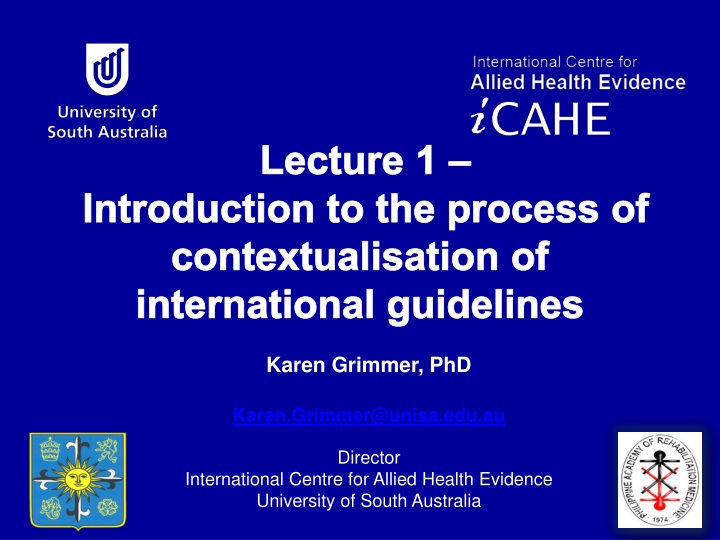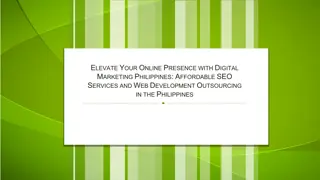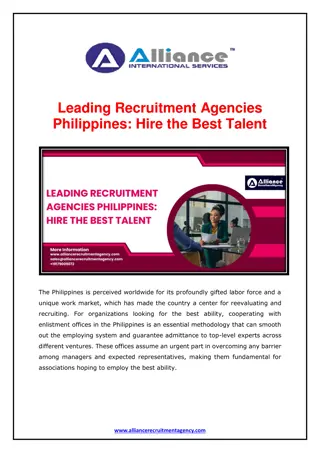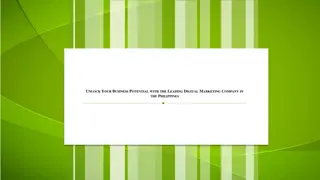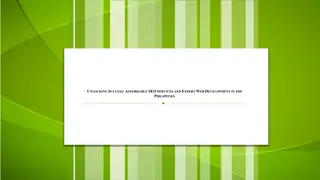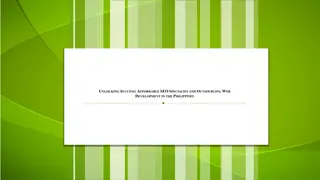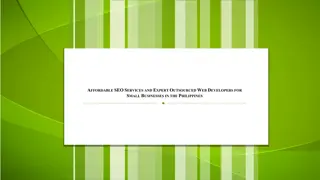Enhancing Healthcare in the Philippines: Contextualizing International Guidelines
The Philippines faces challenges in healthcare access and quality, with significant disparities in resources and training for health workers. Initiatives such as the Continuing Quality Improvement Program aim to address gaps in clinical guidelines dissemination and implementation. The limited workforce, barriers to care, and high burden of diseases like hypertension and stroke highlight the need for evidence-based practices to improve healthcare outcomes.
Download Presentation

Please find below an Image/Link to download the presentation.
The content on the website is provided AS IS for your information and personal use only. It may not be sold, licensed, or shared on other websites without obtaining consent from the author.If you encounter any issues during the download, it is possible that the publisher has removed the file from their server.
You are allowed to download the files provided on this website for personal or commercial use, subject to the condition that they are used lawfully. All files are the property of their respective owners.
The content on the website is provided AS IS for your information and personal use only. It may not be sold, licensed, or shared on other websites without obtaining consent from the author.
E N D
Presentation Transcript
Lecture 1 Introduction to the process of contextualisation of international guidelines Karen Grimmer, PhD Karen.Grimmer@unisa.edu.au Director International Centre for Allied Health Evidence University of South Australia
Background The Philippines is a third-world nation consisting of 7000 islands and 97,484,000 people (end 2013) Health expenditure in 2013 was US$119/year/person Compared with Aus$6,140/year/person Filipinos have variable access to health care, from well-resourced metropolitan tertiary hospitals to remote community health centres staffed by a nurse Private insurance is rare, and there are significant patient-out-of-pocket expenses to access care which must be paid at time of consultation There is no leeway personally, institutionally or nationally for misuse, overuse or underuse of health expenditure Unless care is informed by best evidence, it is likely to be ineffective and wasteful
Impetus for improvement The Philippine government launched a Continuing Quality Improvement (CQI) Program in 2009, with limited funding directed to the development of de novo clinical practice guidelines, but not to dissemination or implementation Hypertension and stroke are 3rd and 4th ranked causes of death Spinal pain is a high-ranked cause of physical disability Both diseases impact on national productivity
Workforce Stroke and low back pain rehabilitation is generally managed by physiatrists There are fewer than 200 rehabilitation physicians (physiatrists) nationwide in 2010 Variable training about, and access to, current best evidence Allied health and nursing providers treat by referrals from physiatrists which dictate prescriptions (what treatment should be provided) Even more variable training about, and access to, current best evidence
Barriers to best care Variable and generally inadequate skills and knowledge of Filipino health workers Hierarchy within healthcare services which makes change difficult Prohibitive costs for patients Limited availability of specialist services Variable equity of access nationwide Physical barriers to care (eg travel) Phil Dept Health 2014
PARM Vision Provide wide access to current best evidence CPGs for physiatrists, GPs, other specialists, allied health, nurses Should de novo guidelines be constructed to guide best practice rehabilitation of Filipino stroke and low back pain patients? Could guidelines from other countries be accessed, and directly implemented?
Challenges Constructing de novo evidence-based guidelines is not simple, quick or inexpensive There was no standard international approach in 2010 to guideline construction The comprehensive McMaster guidance was only released in 2013-14 There was very limited financial support The PARM Group had good will, but limited training and expertise re guidelines
Using other guidelines High quality clinical guidelines support evidence-based care were mostly from Western countries Irrespective of the availability of CPGs, the recommendations had to be acceptable in the Philippines, context-specific and able to be implemented in a range of clinical settings by a range of health practitioners
Implementation barriers Potential barrier(s) Potential barrier(s) Patients expectations Identification and implementing EBP is a difficult process Multidisciplinary teams, uniformity of approach Lack of uniformity, range of service delivery models Changes in leadership Time pressures, cost effectiveness, structural limitations All stakeholders having similar expectations Factor Factor Patient EBP process Team Issues Care process Management Support Time/facilities/cost Health System
Could we be certain that by developing de novo guidelines specifically targeted to Filipino contexts, they would be adopted in practice? Were the issues of implementation as daunting as the issues of guideline production?
Research evidence quality dimensions 1. Hierarchy level study design 2. Study Quality how good is the study? 3. Statistical precision of results statistical significance (p value, confidence limits) 4. Effect size how clinically important are the findings? 5. Relevance usefulness of results in clinical practice NH&MRC (1998)
NH&MRC body of evidence assessment matrix A B C D Component Excellent Good Satisfactory Poor one or two level II studies with low risk of bias or a SR/multiple level III studies with low risk of bias level III studies with low risk of bias, or level I or II studies with moderate risk of bias several level I or II studies with low risk of bias level IV studies, or level I to III studies with high risk of bias Evidence base some inconsistency reflecting genuine uncertainty around clinical question most studies consistent and inconsistency may be explained evidence is inconsistent all studies consistent Consistency very large substantial moderate slight or restricted Clinical impact population/s studied in body of evidence different to target population for guideline but it is clinically sensible to apply this evidence to target population* population/s studied in body of evidence different to target population and hard to judge whether it is sensible to generalise to target population population/s studied in body of evidence are the same as the target population for the guideline population/s studied in the body of evidence are similar to the target population for the guideline Generalisability probably applicable to Australian healthcare context with some caveats directly applicable to Australian healthcare context applicable to Australian healthcare context with few caveats not applicable to Australian healthcare context Applicability Hillier et al 2011
Philosophical debate Can evidence from well-developed guidelines from other countries be readily taken up for Filipinos with stroke or spinal pain? Is it the lack of a Filipino evidence base which is the problem? OR Does it really matter? Is it the issue of getting evidence (any evidence) into local practices?
Local evidence-uptake questions Is a Filipino patient with stroke the same as a Western world patient with stroke? Is the pathology and manifestation the same? Are Western best-evidence statements acceptable in a developing country? Do Filipino physiatrists have the same skills as others in the Western world? Is the Filipino rehabilitation workforce the same as found in other Western countries? Are resources the same? Is there a local will to improve quality care?
De novo or borrow and contextualise? There were many current, good quality CPGs internationally for stroke, and low back pain Was there a need for another CPG specific to Filipino contexts? Could existing CPGs be borrowed, and contextualised, to meet Filipino needs? Separation of the evidence base from generalisability and applicability What was the best use of PARM resources and energies?
Patient journey Our decision hinged on a typical patient journey, and the decision-making points along the way Preliminary scoping of available Western guidelines identified that no one guideline provided recommendations for each decision- making point More than one guideline would be needed to populate the patient journey with best evidence recommendations
What were we doing? Adapt (Encarta English dictionary) to change something to suit different conditions or a different purpose, or be changed in this way Contextualise (Encarta English dictionary) to place a word, phrase, or idea within a suitable context ADAPTE vs our process
Contextualisation We did not adapt any recommendation We developed a standard process of: Distilling the intent of multiple recommendations Synthesising the underlying evidence and the way it was reported We endorsed existing recommendations at each decision-making point We wrote context points which addressed generalisability and applicability (basic and enhanced workforce, training, resources) and appropriate measures of outcome
NH&MRC body of evidence assessment matrix A B C D Component Excellent Good Satisfactory Poor one or two level II studies with low risk of bias or a SR/multiple level III studies with low risk of bias level III studies with low risk of bias, or level I or II studies with moderate risk of bias several level I or II studies with low risk of bias level IV studies, or level I to III studies with high risk of bias Evidence base some inconsistency reflecting genuine uncertainty around clinical question most studies consistent and inconsistency may be explained evidence is inconsistent all studies consistent Consistency very large substantial moderate slight or restricted Clinical impact population/s studied in body of evidence different to target population for guideline but it is clinically sensible to apply this evidence to target population* population/s studied in body of evidence different to target population and hard to judge whether it is sensible to generalise to target population population/s studied in body of evidence are the same as the target population for the guideline population/s studied in the body of evidence are similar to the target population for the guideline Generalisability probably applicable to Filipino healthcare context with some caveats directly applicable to Filipino healthcare context applicable to Filipino healthcare context with few caveats not applicable to Filipino healthcare context Applicability
Our barriers Limited funding Lack of a specific mechanism to map multiple guideline recommendations to single decision-making points in the patient journey Different wording of recommendations, different mechanisms for reporting the evidence base, different references OR same references interpreted differently
No culture of evidence-based practice or quality improvement The need for widespread training in EBP and guideline methodologies in PARM No information on current national practices
Our enablers Dr Gonzalez-Suarez & Dr Dizon A longstanding international collaboration (Australia and Philippines) and access to experienced methodologists Enormous goodwill by PARM members Generosity of time commitment Willingness to learn Commitment to work for the greater good Enjoyment of the process (even making mistakes)
Our way forward PARM decided to: Use the existing evidence base for its contextualised guidelines Invest effort in understanding how to get the evidence into practice across the Philippines Value the spin-offs Training opportunities Engage as many PARM members as possible to ensure later commitment to evidence uptake Focus on contextual barriers
We decided to share our work and experience at the G-I-N 2014 conference with the theme Creation and Innovation: Guidelines in the Digital Age Our work fits in the context of both creation and innovation
Our main aim is to teach and guide the participants in our process of contextualisation to come up with more practical recommendations which are based on current evidence and relevant to the management of specific conditions
Overall, the workshop objectives are for the participants to: Have a clear understanding of the process and practicalities of contextualisation of international guidelines Have a clear understanding of how to source and appraise existing international guidelines to be used as basis for contextualisation Have knowledge of identifying patient journeys to map international guidelines with local practice Have knowledge and skills to apply the contextualisation process in at least one condition relevant to them.
